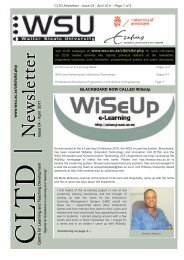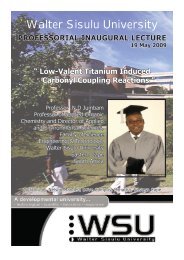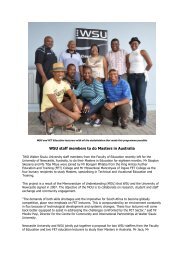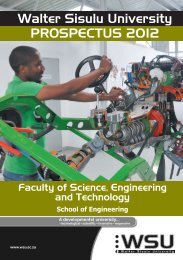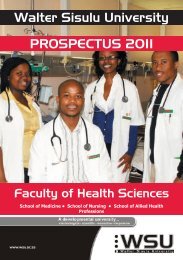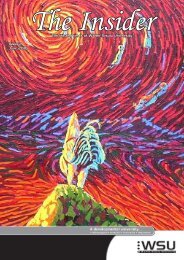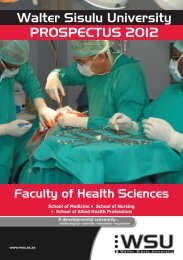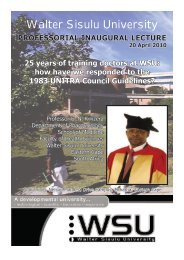School of Computing prospectus 2012 - Walter Sisulu University
School of Computing prospectus 2012 - Walter Sisulu University
School of Computing prospectus 2012 - Walter Sisulu University
Create successful ePaper yourself
Turn your PDF publications into a flip-book with our unique Google optimized e-Paper software.
Statistical Mechanics & Solid State Physics<br />
Code Course NQF Level Credits Semester<br />
PHY3202 Statistical Mechanics & Solid<br />
State Physics<br />
Lectures per week Laboratory sessions per week Tutorials<br />
per week<br />
41<br />
7 24 2<br />
Number<br />
<strong>of</strong><br />
weeks<br />
4 x 50 min 2 x 180 min 2 x 50 min 15 240<br />
Notional<br />
hrs<br />
Content / Syllabus: Statistical Mechanics: Statistical equilibrium; The Maxwell-Boltzmann<br />
distribution law; Thermal equilibrium; Application to Ideal gas; Entropy and<br />
heat in terms <strong>of</strong> statistical probability; Heat capacity <strong>of</strong> ideal monatomic and<br />
an ideal polyatomic gas; The principle <strong>of</strong> equipartition <strong>of</strong> energy; The Einstein<br />
Solid; Fermi-Dirac distribution law; The electron gas; Application <strong>of</strong> Fermi-<br />
Dirac statistics to electrons in metals; Bose-Einstein distribution law; The<br />
photon gas; Heat capacities <strong>of</strong> vibrating molecules and <strong>of</strong> solid bodies.<br />
Solid State Physics: Crystals: binding, structure, defects and growing<br />
techniques. Lattices dynamics: quantized vibrations, phonons and density <strong>of</strong><br />
states, specific heat capacity and Debye law. Free electron theory <strong>of</strong> metals:<br />
density <strong>of</strong> states, specific heat capacity, electrical conductivity and Hall effect,<br />
Pauli paramagnetism, thermionic emission. Comparison <strong>of</strong> metals, insulators,<br />
semimetals and semiconductors, band structure. Magnetic properties <strong>of</strong><br />
materials: types <strong>of</strong> magnetism, susceptibility and permeability. Dielectrics:<br />
polarization, temperature and frequency dependence <strong>of</strong> permittivity,<br />
ferroelectric and piezoelectric materials. Semiconductors: holes and conduction<br />
electrons, intrinsic and extrinsic semiconductors, donors and acceptors,<br />
temperature dependency <strong>of</strong> electrical conductivity<br />
Assessment: Modules mark (M) will be obtained from continuous assessment based on<br />
quizzes, tutorials, seminar presentations, lab reports, and tests. The final mark<br />
will be obtained from the Module mark (M) and Summative Assessment (E) in<br />
the ratio 3:2.<br />
Entry Assumptions/Pre-requisites: PHY2101, PHY2202, MAT2101, MAT2102, MAT2201, MAT2202<br />
Co-requisites: None<br />
<strong>2012</strong><br />
PROSPECTUS



